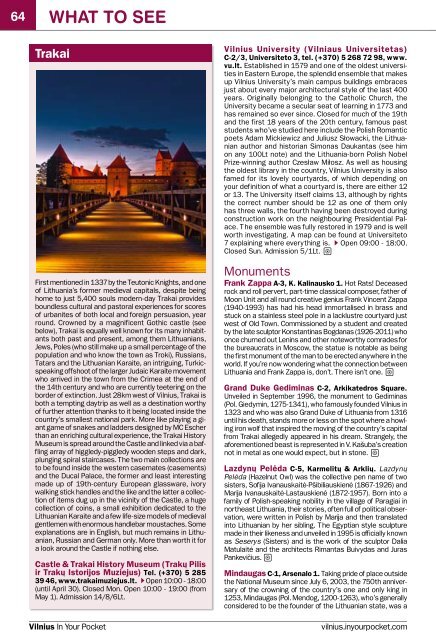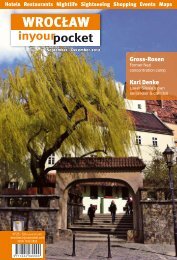VILNIUS - In Your Pocket
VILNIUS - In Your Pocket
VILNIUS - In Your Pocket
You also want an ePaper? Increase the reach of your titles
YUMPU automatically turns print PDFs into web optimized ePapers that Google loves.
64 what to see<br />
Trakai<br />
First mentioned in 1337 by the Teutonic Knights, and one<br />
of Lithuania’s former medieval capitals, despite being<br />
home to just 5,400 souls modern-day Trakai provides<br />
boundless cultural and pastoral experiences for scores<br />
of urbanites of both local and foreign persuasion, year<br />
round. Crowned by a magnificent Gothic castle (see<br />
below), Trakai is equally well known for its many inhabitants<br />
both past and present, among them Lithuanians,<br />
Jews, Poles (who still make up a small percentage of the<br />
population and who know the town as Troki), Russians,<br />
Tatars and the Lithuanian Karaite, an intriguing, Turkicspeaking<br />
offshoot of the larger Judaic Karaite movement<br />
who arrived in the town from the Crimea at the end of<br />
the 14th century and who are currently teetering on the<br />
border of extinction. Just 28km west of Vilnius, Trakai is<br />
both a tempting daytrip as well as a destination worthy<br />
of further attention thanks to it being located inside the<br />
country’s smallest national park. More like playing a giant<br />
game of snakes and ladders designed by MC Escher<br />
than an enriching cultural experience, the Trakai History<br />
Museum is spread around the Castle and linked via a baffling<br />
array of higgledy-piggledy wooden steps and dark,<br />
plunging spiral staircases. The two main collections are<br />
to be found inside the western casemates (casements)<br />
and the Ducal Palace, the former and least interesting<br />
made up of 19th-century European glassware, ivory<br />
walking stick handles and the like and the latter a collection<br />
of items dug up in the vicinity of the Castle, a huge<br />
collection of coins, a small exhibition dedicated to the<br />
Lithuanian Karaite and a few life-size models of medieval<br />
gentlemen with enormous handlebar moustaches. Some<br />
explanations are in English, but much remains in Lithuanian,<br />
Russian and German only. More than worth it for<br />
a look around the Castle if nothing else.<br />
Castle & Trakai History Museum (Trakų Pilis<br />
ir Trakų Istorijos Muziejus) Tel. (+370) 5 285<br />
39 46, www.trakaimuziejus.lt. QOpen 10:00 - 18:00<br />
(until April 30). Closed Mon. Open 10:00 - 19:00 (from<br />
May 1). Admission 14/8/6Lt.<br />
Vilnius University (Vilniaus Universitetas)<br />
C-2/3, Universiteto 3, tel. (+370) 5 268 72 98, www.<br />
vu.lt. Established in 1579 and one of the oldest universities<br />
in Eastern Europe, the splendid ensemble that makes<br />
up Vilnius University’s main campus buildings embraces<br />
just about every major architectural style of the last 400<br />
years. Originally belonging to the Catholic Church, the<br />
University became a secular seat of learning in 1773 and<br />
has remained so ever since. Closed for much of the 19th<br />
and the first 18 years of the 20th century, famous past<br />
students who’ve studied here include the Polish Romantic<br />
poets Adam Mickiewicz and Juliusz Słowacki, the Lithuanian<br />
author and historian Simonas Daukantas (see him<br />
on any 100Lt note) and the Lithuania-born Polish Nobel<br />
Prize-winning author Czesław Miłosz. As well as housing<br />
the oldest library in the country, Vilnius University is also<br />
famed for its lovely courtyards, of which depending on<br />
your definition of what a courtyard is, there are either 12<br />
or 13. The University itself claims 13, although by rights<br />
the correct number should be 12 as one of them only<br />
has three walls, the fourth having been destroyed during<br />
construction work on the neighbouring Presidential Palace.<br />
The ensemble was fully restored in 1979 and is well<br />
worth investigating. A map can be found at Universiteto<br />
7 explaining where everything is. QOpen 09:00 - 18:00.<br />
Closed Sun. Admission 5/1Lt. J<br />
Monuments<br />
Frank Zappa A-3, K. Kalinausko 1. Hot Rats! Deceased<br />
rock and roll pervert, part-time classical composer, father of<br />
Moon Unit and all round creative genius Frank Vincent Zappa<br />
(1940-1993) has had his head immortalised in brass and<br />
stuck on a stainless steel pole in a lacklustre courtyard just<br />
west of Old Town. Commissioned by a student and created<br />
by the late sculptor Konstantinas Bogdanas (1926-2011) who<br />
once churned out Lenins and other noteworthy comrades for<br />
the bureaucrats in Moscow, the statue is notable as being<br />
the first monument of the man to be erected anywhere in the<br />
world. If you’re now wondering what the connection between<br />
Lithuania and Frank Zappa is, don’t. There isn’t one. J<br />
Grand Duke Gediminas C-2, Arkikatedros Square.<br />
Unveiled in September 1996, the monument to Gediminas<br />
(Pol. Giedymin, 1275-1341), who famously founded Vilnius in<br />
1323 and who was also Grand Duke of Lithuania from 1316<br />
until his death, stands more or less on the spot where a howling<br />
iron wolf that inspired the moving of the country’s capital<br />
from Trakai allegedly appeared in his dream. Strangely, the<br />
aforementioned beast is represented in V. Kašuba’s creation<br />
not in metal as one would expect, but in stone. J<br />
Lazdynų Pelėda C-5, Karmelitų & Arklių. Lazdynų<br />
Pelėda (Hazelnut Owl) was the collective pen name of two<br />
sisters, Sofija Ivanauskaitė-Pšibiliauskienė (1867-1926) and<br />
Marija Ivanauskaitė-Lastauskienė (1872-1957). Born into a<br />
family of Polish-speaking nobility in the village of Paragiai in<br />
northeast Lithuania, their stories, often full of political observation,<br />
were written in Polish by Marija and then translated<br />
into Lithuanian by her sibling. The Egyptian style sculpture<br />
made in their likeness and unveiled in 1995 is officially known<br />
as Seserys (Sisters) and is the work of the sculptor Dalia<br />
Matulaitė and the architects Rimantas Buivydas and Juras<br />
Pankevičius. J<br />
Mindaugas C-1, Arsenalo 1. Taking pride of place outside<br />
the National Museum since July 6, 2003, the 750th anniversary<br />
of the crowning of the country’s one and only king in<br />
1253, Mindaugas (Pol. Mendog, 1200-1263), who’s generally<br />
considered to be the founder of the Lithuanian state, was a<br />
Vilnius <strong>In</strong> <strong>Your</strong> <strong>Pocket</strong> vilnius.inyourpocket.com
















